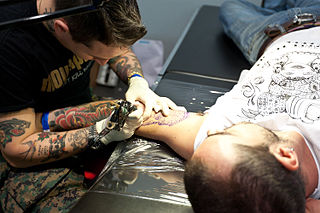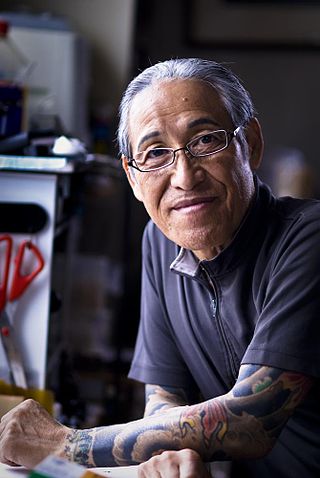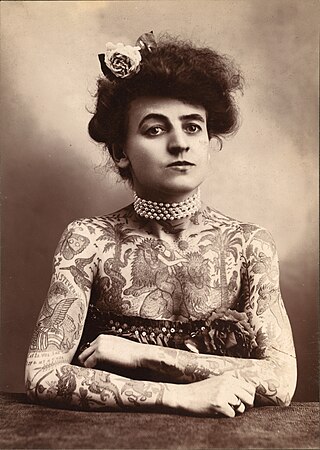Related Research Articles

A tattoo is a form of body modification made by inserting tattoo ink, dyes, and/or pigments, either indelible or temporary, into the dermis layer of the skin to form a design. Tattoo artists create these designs using several tattooing processes and techniques, including hand-tapped traditional tattoos and modern tattoo machines. The history of tattooing goes back to Neolithic times, practiced across the globe by many cultures, and the symbolism and impact of tattoos varies in different places and cultures.

Inked is a tattoo lifestyle digital media company that bills itself as the outsiders' insider media. Covering music, fashion, art, sports and the rest of the lifestyle of the tattooed, Inked, like Vice, has made the transition from the newsstand to digital media company. Tattooed women like Kat Von D, Avril Lavigne, Diablo Cody, Eve and Malin Akerman have appeared on Inked's cover. Among the celebrities who have sat down with Inked are Ozzy Osbourne, Lil Pump, Tracy Morgan, Slash, Kid Cudi and Billie Joe Armstrong. Inked also covers tattoo artists; they immortalize the best in their Icon feature through which the likes of Don Ed Hardy, Horiyoshi III and Ami James have been honored.
Mark Machado, better known as Mister Cartoon or more commonly just Cartoon or Toon, is an American tattoo artist and graffiti artist based in Los Angeles, California. He has been described by the New York Times as an "instrumental figure in the Los Angeles hip-hop scene" and by the BBC as "one of the greatest living tattoo artists in the US". Growing up in the Harbor area of Los Angeles County, young Cartoon began doing illustrations and graffiti then going on to airbrushing clothing and lowrider custom cars. Machado then moved on to working in the music industry doing album covers, tour merchandise and later tattooing recording artists and other celebrities.
Patrick Conlon is an illustrator and tattooist in New York City. He wrote and illustrated the graphic novel Swarm, and collaborated with Michael Manning, another fetish artist, on The Tranceptor Series. He has tattooed and worked with several celebrities, most notably Daniel Day-Lewis and a small umbrella piece on Rihanna.

Norman Keith Collins, known popularly as Sailor Jerry, was a prominent American tattoo artist in Hawaii who was well known for his tattoo designs.

A tattoo artist is an individual who applies permanent decorative tattoos, often in an established business called a "tattoo shop", "tattoo studio" or "tattoo parlour". Tattoo artists usually learn their craft via an apprenticeship under a trained and experienced mentor.

Don Ed Hardy is an American tattoo artist known for his tattoos, strong influence on the development of modern tattoo styles, and his eponymous apparel and accessories brand.

Lyle Gilbert Tuttle was an American tattoo artist and historian of the medium, who had been tattooing since 1949. He tattooed Janis Joplin, Cher, Jo Baker, Paul Stanley, Jeff Scranton, and many other American musicians, actors, and celebrities.

Modern Primitives, written by V. Vale and Andrea Juno, is a RE/Search publications book about body modification, published in 1989. The book consists of a collection of twenty two interviews and two essays with individuals and key figures involved in the field of body modification in the late 1980s. It was one of the first documents to attempt to comprehensively cover the re-emergence and increasing popularity of tattooing, piercing, scarification, corsetry, sideshow, ritual and other practices in contemporary western society.

Horiyoshi III is a horishi, specializing in Japanese traditional full-body tattoos, or "suits," called Irezumi or Horimono.

The Peʻa is the popular name of the traditional male tatau (tattoo) of Samoa, also known as the malofie. It is a common mistake for people to refer to the pe'a as sogaimiti, because sogaimiti refers to the man with the pe'a and not the pe'a itself. It covers the body from the middle of the back to the knees, and consists of heavy black lines, arrows, and dots.

Leo Zulueta is an American tattoo artist. He is known as the "father of modern tribal tattooing."

Alex Binnie is a tattooist, and printmaker; he has been a musician and performance artist.

Mary Jane Haake is an American tattoo artist and authority on medical tattooing and permanent makeup. She was instrumental in bringing topical anesthetics to the tattooing and body modification industries.

Greg James is a well-known tattoo artist. Greg's tattoo designs and original artwork have appeared in magazines, books, documentaries, and at the Hard Rock Cafe.
Sara Fabel is a Finnish model, illustrator, tattoo artist, and actress.

Maud Stevens Wagner was an American circus performer. She was the first known female tattoo artist in the United States.
Jessie Marjorie Knight was the first prominent female tattoo artist in the UK.
Kari Barba is an American tattoo artist and painter from Minneapolis. Barba has been practicing art for over 45 years and is best known for her work for women within the tattoo industry. Barba is based in Long Beach, California. She is co-owner of Outer Limits Tattoo in Long Beach, CA, the oldest tattoo shop in the United States. She also owns Outer Limits Tattoo in Costa Mesa

Bert Grimm was an American tattoo artist dubbed the "grandfather of old school". Grimm's work and mentorship contributed to the development and popularity of the American Traditional tattoo style. He is said to have tattooed Bonnie and Clyde and Pretty Boy Floyd, among others.
References
- 1 2 DeMello, Margo (2007). Encyclopedia of body adornment. Westport, CT: Greenwood Press. pp. 177–178. ISBN 9780313336959. OCLC 123767012 . Retrieved 2019-02-16.
- 1 2 Bunch, Riley (2018-07-02). "Seattle's First Lady of Tattoo reflects on nearly half a century of work". Seattle Refined. Retrieved 2019-02-17.
- ↑ "Artist Profile: Beverly "Vyvyn" Lazonga". Needled.com. 14 June 2005. Archived from the original on 2006-11-19. Retrieved 2007-01-06.
- ↑ Davila, Florangela (March 12, 2006). "Redefining beauty: Jackie's journey through cancer". The Seattle Times . Retrieved 2007-01-06.
- 1 2 Vale, Vivian; Juno, Andrea (October 4, 1989). Modern Primitives. San Francisco: Re/Search Publications. ISBN 0-940642-14-X.
- 1 2 Mifflin, Margot (October 1997). Bodies of Subversion. New York: Juno Books. ISBN 1-890451-00-2.
- 1 2 Lautman, Victoria (November 1994). The New Tattoo . New York: Abbeville Press. ISBN 1-55859-785-9.
- ↑ Baxter, Bob (2002). Tattoo Road Trip. Atglen, PA: Schiffer Publishing. ISBN 0-7643-1522-6.
- ↑ Skin and Ink magazine
- ↑ "2005 tattoo contest winners". National Tattoo Association. Retrieved 2006-01-06.